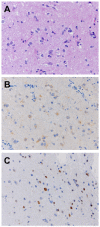The role of glioma stem cells in chemotherapy resistance and glioblastoma multiforme recurrence
- PMID: 26027432
- PMCID: PMC4830899
- DOI: 10.1586/14737175.2015.1051968
The role of glioma stem cells in chemotherapy resistance and glioblastoma multiforme recurrence
Abstract
Glioma stem cells (GSCs) constitute a slow-dividing, small population within a heterogeneous glioblastoma. They are able to self-renew, recapitulate a whole tumor, and differentiate into other specific glioblastoma multiforme (GBM) subpopulations. Therefore, they have been held responsible for malignant relapse after primary standard therapy and the poor prognosis of recurrent GBM. The failure of current therapies to eliminate specific GSC subpopulations has been considered a major factor contributing to the inevitable recurrence in GBM patients after treatment. Here, we discuss the molecular mechanisms of chemoresistance of GSCs and the reasons why complete eradication of GSCs is so difficult to achieve. We will also describe the targeted therapies currently available for GSCs and possible mechanisms to overcome such chemoresistance and avoid therapeutic relapse.
Keywords: chemoresistance; glioma stem cells; malignant glioma; mechanisms; plasticity; recurrence.
Figures



References
-
- Legler JM, Ries LA, Smith MA, et al. Cancer surveillance series [corrected]: brain and other central nervous system cancers: recent trends in incidence and mortality. Journal of the National Cancer Institute. 1999;91(16):1382–1390. - PubMed
-
- Stupp R, Dietrich PY, Ostermann Kraljevic S, et al. Promising survival for patients with newly diagnosed glioblastoma multiforme treated with concomitant radiation plus temozolomide followed by adjuvant temozolomide. Journal of clinical oncology: official journal of the American Society of Clinical Oncology. 2002;20(5):1375–1382. - PubMed
-
- Stupp R, Mason WP, van den Bent MJ, et al. Radiotherapy plus concomitant and adjuvant temozolomide for glioblastoma. The New England journal of medicine. 2005;352(10):987–996. - PubMed
Publication types
MeSH terms
Substances
Grants and funding
LinkOut - more resources
Full Text Sources
Other Literature Sources
Medical
Research Materials
